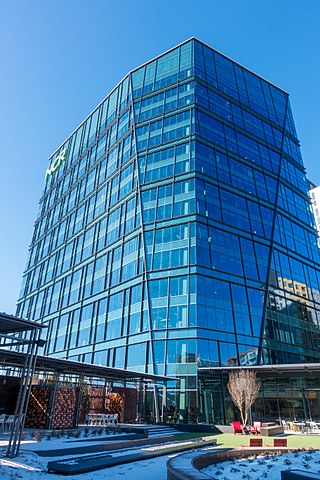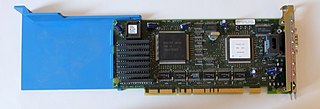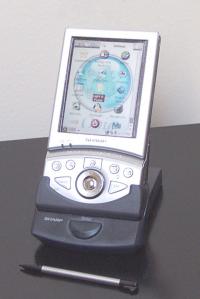
Multiple Virtual Storage, more commonly called MVS, was the most commonly used operating system on the System/370 and System/390 IBM mainframe computers. IBM developed MVS, along with OS/VS1 and SVS, as a successor to OS/360. It is unrelated to IBM's other mainframe operating system lines, e.g., VSE, VM, TPF.

An operating system (OS) is system software that manages computer hardware, software resources, and provides common services for computer programs.

Windows 95 is a consumer-oriented operating system developed by Microsoft as part of its Windows 9x family of operating systems. The first operating system in the 9x family, it is the successor to Windows 3.1x, and was released to manufacturing on July 14, 1995, and generally to retail on August 24, 1995, almost three months after the release of Windows NT 3.51. Windows 95 merged Microsoft's formerly separate MS-DOS and Microsoft Windows products, and featured significant improvements over its predecessor, most notably in the graphical user interface (GUI) and in its simplified "plug-and-play" features. There were also major changes made to the core components of the operating system, such as moving from a mainly cooperatively multitasked 16-bit architecture to a 32-bit preemptive multitasking architecture, at least when running only 32-bit protected mode applications.
DNIX is a discontinued Unix-like real-time operating system from the Swedish company Dataindustrier AB (DIAB). A version named ABCenix was developed for the ABC 1600 computer from Luxor. Daisy Systems also had a system named Daisy DNIX on some of their computer-aided design (CAD) workstations. It was unrelated to DIAB's product.

UAE is a computer emulator which emulates the hardware of Commodore International's Amiga range of computers. Released under the GNU General Public License, UAE is free software.

NCR Corporation, previously known as National Cash Register, is an American software, consulting and technology company providing several professional services and electronic products. It manufactures self-service kiosks, point-of-sale terminals, automated teller machines, check processing systems, and barcode scanners.

Micro Channel architecture, or the Micro Channel bus, is a proprietary 16- or 32-bit parallel computer bus introduced by IBM in 1987 which was used on PS/2 and other computers until the mid-1990s. Its name is commonly abbreviated as "MCA", although not by IBM. In IBM products, it superseded the ISA bus and was itself subsequently superseded by the PCI bus architecture.

The Sharp Zaurus is the name of a series of personal digital assistants (PDAs) made by Sharp Corporation. The Zaurus was the most popular PDA during the 1990s in Japan and was based on a proprietary operating system. The first Sharp PDA to use the Linux operating system was the SL-5000D, running the Qtopia-based Embedix Plus. The Linux Documentation Project considers the Zaurus series to be "true Linux PDAs" because their manufacturers install Linux-based operating systems on them by default. The name derives from the common suffix applied to the names of dinosaurs.

VM is a family of IBM virtual machine operating systems used on IBM mainframes System/370, System/390, zSeries, System z and compatible systems, including the Hercules emulator for personal computers.

Network-attached storage (NAS) is a file-level computer data storage server connected to a computer network providing data access to a heterogeneous group of clients. The term "NAS" can refer to both the technology and systems involved, or a specialized device built for such functionality.

The DECstation was a brand of computers used by DEC, and refers to three distinct lines of computer systems—the first released in 1978 as a word processing system, and the latter two both released in 1989. These comprised a range of computer workstations based on the MIPS architecture and a range of PC compatibles. The MIPS-based workstations ran ULTRIX, a DEC-proprietary version of UNIX, and early releases of OSF/1.
Stratus VOS is a proprietary operating system running on Stratus Technologies fault-tolerant computer systems. VOS is available on Stratus's ftServer and Continuum platforms. VOS customers use it to support high-volume transaction processing applications which require continuous availability. VOS is notable for being one of the few operating systems which run on fully lockstepped hardware.

QEMU is a free and open-source emulator. It emulates the machine's processor through dynamic binary translation and provides a set of different hardware and device models for the machine, enabling it to run a variety of guest operating systems. It can interoperate with Kernel-based Virtual Machine (KVM) to run virtual machines at near-native speed. QEMU can also do emulation for user-level processes, allowing applications compiled for one architecture to run on another.

The IBM 6580 Displaywriter System is a 16-bit microcomputer that was marketed and sold by IBM's Office Products Division primarily as a word processor. Announced in June 1980 and effectively withdrawn from marketing in July 1986, the system was sold with a 5 MHz Intel 8086, 128K to 448K of RAM, a swivel-mounted monochrome CRT monitor, a detached keyboard, a detached 8" floppy disk drive enclosure with one or two drives, and a detached daisy wheel printer, or Selectric typewriter printer. The primary operating system for the Displaywriter is IBM's internally developed word processing software titled "Textpack", but UCSD p-System, CP/M-86 and MS-DOS were also offered by IBM, Digital Research and CompuSystems, respectively.
Transaction processing is a way of computing that divides work into individual, indivisible operations, called transactions. A transaction processing system (TPS) is a software system, or software/hardware combination, that supports transaction processing.
Corvus Systems was a computer technology company that offered, at various points in its history, computer hardware, software, and complete PC systems.

Oracle VM VirtualBox is a type-2 hypervisor for x86 virtualization developed by Oracle Corporation. VirtualBox was originally created by Innotek GmbH, which was acquired by Sun Microsystems in 2008, which was in turn acquired by Oracle in 2010.

The SystemPro from Compaq, released in November 1989, is a computer capable of running server-based computer operating systems and was arguably the first true PC based server. It supports Intel's 486 chip, a 32-bit bus, RAID disk and dual-processor support well before its main rivals.
In computing, virtualization or virtualisation is the act of creating a virtual version of something at the same abstraction level, including virtual computer hardware platforms, storage devices, and computer network resources.

MS-DOS is an operating system for x86-based personal computers mostly developed by Microsoft. Collectively, MS-DOS, its rebranding as IBM PC DOS, and a few operating systems attempting to be compatible with MS-DOS, are sometimes referred to as "DOS". MS-DOS was the main operating system for IBM PC compatibles during the 1980s, from which point it was gradually superseded by operating systems offering a graphical user interface (GUI), in various generations of the graphical Microsoft Windows operating system.














